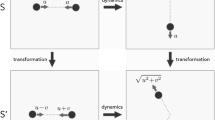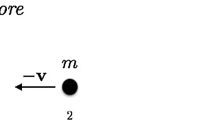Abstract
We propose a new interpretation of the equation \(E=mc^2\) in special relativity by generalizing ideas of ontological emergence to fundamental physics. This allows us to propose that mass, as a property, can be considered to emerge from energy, using a well-known definition of weak ontological emergence. Einstein’s famous equation gains in this way a clearer philosophical interpretation, one that avoids the problems of previous attempts, and is fully consistent with the kinematic properties of special relativity, while yielding fresh insights concerning the nature of mass.
Similar content being viewed by others
Notes
Note that, within classical mechanics, it is always possible to choose a frame of reference and the zeros of potential energy in such a way that, at a given time along the evolution of a system, the net value of its total energy is equal to zero. Here we refer to a deeper fact revealed by special relativity, namely that the invariant mass of some physical system, i.e. the modulus of the energy-momentum four-vector, can be zero although its total energy cannot be zero for any non-trivial case.
An individual particle can have kinetic energy, but this is only once a reference frame, or idealized observer, is set—the particle has a kinetic energy with respect to a certain reference frame—i.e. a relational property.
One could see this interpretation as equivalent to saying that mass is just an illusion, and that energy is all there is to matter. But inertia is a measurable, real property, different from the energy of an object, and mass is just a quantification of inertia.
Already in 1913 Alexander Bogdánov, the unrecognized father of systems theory,while studying the widely used emergentist aphorism ‘the whole is greater than the sum of its parts’, had noted that according to contemporary physics “...the weight of a sack of potatoes must not be exactly equal to the sum of the separately measured weights of each spud and the sack; their mutual attraction alters, depending upon their spatial situation, this sum.”
Because there has been some confusion about this, technically, for a standard quartic Higgs potential, the Higgs mass term in the standard model Lagrangian is proportional to the vev at tree level. This mass term, which reads \(m^2 \phi ^\dagger \phi =\frac{\lambda }{6} v^2 \phi ^\dagger \phi \) (\(\lambda \) being the Higgs self-interaction coupling, \(\phi \) the Higgs field, and v the vev) reads the same way as an interaction term between the Higgs field and a constant external scalar field. Of course, as with all equalities, this equality can be (and has been) interpreted the other way around: as implying that the mass of the Higgs is the originator of the vev of the field—but our reading of it is just as valid, and consistent with the rest of the standard model.
Of course, physicists’ use of the word ‘emergence’ is more loose than that of philosophers, but their views are naturally important for the interpretation of physics, and provide an intuition pump for us.
References
Armstrong, D.M.: A theory of universals: volume 2: universals and scientific realism, volume 2. CUP Archive (1978)
Bauer, W.A.: An argument for the extrinsic grounding of mass. Erkenntnis 74(1), 81–99 (2011)
Bondi, H., Spurgin, C.: Energy has mass: a common misunderstanding is re-examined. Phys. Bull. 38(2), 62 (1987)
Butterfield, J.: Emergence, reduction and supervenience: a varied landscape. Found. Phys. 41(6), 920–959 (2011)
Chalmers, D.: Strong and weak emergence the re-emergence of emergence ed P. Clayton and P Davies (2006)
Coffey, K.: On the ontology of particle mass and energy in special relativity. Synthese 198, 10817–10846 (2020)
Crowther, K.: Inter-theory relations in quantum gravity: correspondence, reduction, and emergence. Stud Hist Philos Sci Part B: Stud Hist Philos Mod Phys 63, 74–85 (2018)
Crowther, K.: As below, so before:‘synchronic’ and ‘diachronic’ conceptions of spacetime emergence. Synthese 198(8), 7279–7307 (2020)
Eddington, A.: Space. An Outline of the General Relativity Theory. Cambridge University Press, Time and Gravitation (1920)
Einstein, A.: Does the inertia of a body depend upon its energy-content. Annalen der Physik 18(13), 639–641 (1905)
Flores, F.: Einstein’s theory of theories and types of theoretical explanation. Int. Stud. Philos. Sci. 13(2), 123–134 (1999)
Flores, F.: Interpretations of Einstein’s equation e= mc 2. Int. Stud. Philos. Sci. 19(3), 245–260 (2005)
Flores, F.: The equivalence of mass and energy. In: E.N. Zalta (ed.) The Stanford Encyclopedia of Philosophy (Spring 2012 ed.) (2012)
Guay, A., Sartenaer, O.: A new look at emergence. Or when after is different. Eur. J. Philos. Sci. 6(2), 297–322 (2016)
Kim, J.: Making sense of emergence. Philos. Stud. 95(1), 3–36 (1999)
Krajewski, W.: On the interpretation of the equation e = mc 2: reply to flores. Int. Stud. Philos. Sci. 20(2), 215–216 (2006)
Lange, M.: The most famous equation. J. Philos. 98(5), 219–238 (2001)
Lange, M.: Introduction to the Philosophy of Physics. Blackwell Publishers, Hoboken (2002)
Le Bihan, B.: Space emergence in contemporary physics: why we do not need fundamentality, layers of reality and emergence. Disputatio 10(49) (2018)
Lombardi, O.: The ontological autonomy of the chemical world: facing the criticisms. In: Philosophy of Chemistry, pp. 23–38. Springer (2015)
Macdonald, C., Macdonald, G.: Mental causes and explanation of action. Philos. Q. 36(143), 145–158 (1986)
Macdonald, C., Macdonald, G.: How to be psychologically relevant. In: Macdonald, C., Macdonald, G. (eds.) Philosophy of Psychology: Debates on Psychological Explanation. Basil Blackwell Ltd, Oxford (1995)
Macdonald, C., Macdonald, G.: The metaphysics of mental causation. J. Philos. 103(11), 539–576 (2006)
Macdonald, G.: Emergence and causal powers. Erkenntnis 67(2), 239–253 (2007)
Mitchell, S.D.: Emergence: logical, functional and dynamical. Synthese 185(2), 171–186 (2012)
Okun, L.B.: The concept of mass. Phys. Today 42(6), 31–36 (1989)
Primas, H.: Emergence in exact natural science (1998)
Rindler, W.: Essential Relativity: Special, General, and Cosmological. Texts and Monographs in Physics, Springer, Berlin (1977)
Romero-Maltrana, D., Benitez, F., Soto, C.: A proposal for a coherent ontology of fundamental entities. Found. Sci. 1–13 (2018)
Sartenaer, O.: Flat emergence. Pac. Philos. Q. 99, 225–250 (2018)
Torretti, R.: Relativity and Geometry. Dover Books on Physics Series. Dover Publications, Incorporated, New York (2012)
Weinberg, S.: The Quantum Theory of Fields, Foundations, vol. 1. Cambridge University Press, Cambridge (2005)
Weyl, H.: Symmetry. Princeton University Press, Princeton (1952)
Wilczek, F.: Whence the force of f= ma? iii: cultural diversity. Phys. Today 58(7), 10–11 (2005)
Wilczek, F.: Origins of mass. Cent. Eur. J. Phys. 10(5), 1021–1037 (2012)
Wilson, J.: Metaphysical Emergence: Weak and Strong, vol. 251. Brill, Leiden (2015)
Wimsatt, W.C.: Aggregativity: reductive heuristics for finding emergence. Philos. Sci. 64, S372–S384 (1997)
Wimsatt, W.C.: Emergence as non-aggregativity and the biases of reductionisms. Found. Sci. 5(3), 269–297 (2000)
Yablo, S.: Mental causation. Philos. Rev. 101(2), 245–280 (1992)
Funding
This work was supported by the Fondo Nacional de Desarrollo Científico y Tecnológico FONDECYT Chile under Grants No. 1150661, 1150052, as well as by the Swiss National Science Foundation under Grant No. 105212-175971.
Author information
Authors and Affiliations
Corresponding author
Additional information
Publisher's Note
Springer Nature remains neutral with regard to jurisdictional claims in published maps and institutional affiliations.
Rights and permissions
About this article
Cite this article
Benitez, F., Romero-Maltrana, D. & Razeto-Barry, P. (Re)interpreting \(E=mc^2\). Found Phys 52, 15 (2022). https://doi.org/10.1007/s10701-021-00530-0
Received:
Accepted:
Published:
DOI: https://doi.org/10.1007/s10701-021-00530-0




